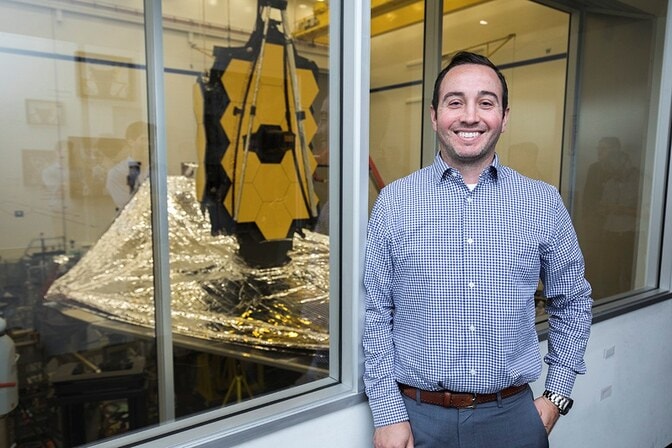
Launching the world’s largest space telescope
Robby Swoish (BS AERO ’06, MS CLaSP ’07) helped deploy the James Webb Space Telescope.

Robby Swoish (BS AERO ’06, MS CLaSP ’07) helped deploy the James Webb Space Telescope.
The James Webb Space Telescope is safe from the sun’s light and heat thanks, in part, to Robby Swoish. The largest and most powerful telescope ever launched into space, Webb is designed to study galaxies so far away that their light takes 13.5 billion years to reach us. That ancient light gives us a view of our universe that dates back to the origins of the very first stars.
As one of the commissioning engineering leads for Webb at Northrop Grumman in 2021, Swoish helped direct the delicate task of unfolding the telescope’s fragile, tennis-court-sized sun shield after Webb arrived in orbit. Composed of Kapton, a thin, heat-resistant film, the shield was carefully folded around the telescope’s observatory so that it could fit into the nose of a rocket. Once in space, it had to be unfolded remotely. Swoish helped plan, develop, test and execute the computer code and sequence of events that orchestrated the process.
For Swoish, the groundbreaking launch was the culmination of a dream that began in the rural Thumb region of Michigan. During his high school summers, he spent his days working in his father’s auto body shop and his nights gazing up at the clear, dark sky.
“Working with my hands and always seeing those clear skies is kind of what drove me into aerospace,” he said. “It’s just humbling to look up at the vastness of space and think about what a small piece of the universe we are, and yet how much we’ve been able to advance and develop technologies as a species.”
Swoish became a first-generation college student, earning a bachelor’s degree in aerospace engineering before moving on to a master’s program in space engineering.
“We had a lot of hands-on systems engineering projects where we would go through full system-level designs of space vehicles,” he said. “That really helped prepare me a lot for Northrop.”
Swoish also took a leadership role on a student team facilitated by U-M, tackling the task of building a low-cost space telescope.
“We got to work with optics, we got to work with an industry partner who was our customer, and then we actually got to build hardware and manage the program and the schedule and the budget,” he said. “So that I think really prepared me well to go into industry.”
His work paid off at a North Campus career fair when he interviewed with Northrop Grumman—by a U-M alum who had also been through the space engineering program and knew how well it had prepared Swoish for the position.
Today, Swoish continues to manage teams that are constantly optimizing Webb’s operations and monitoring its vitals–such as temperature and voltage–to ensure it stays healthy.
When he comes home to rural Michigan, he still gazes up at the night sky—now with the knowledge that the telescope he helped launch is safely in orbit, gathering data to spark awe and move humanity forward.
“It’s rewarding to be able to look at this huge observatory that’s out in space and be able to tweak it and make it better, even after it’s designed and launched and deployed,” he said. “We can still always make it better.”